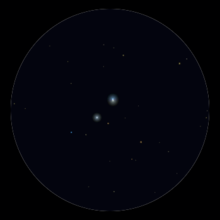Beta Tucanae
Beta Tucanae (β Tuc, β Tucanae) is a group of six stars which appear to be at least loosely bound into a system in the constellation Tucana. Three of the stars are luminous and distinct enough to have been given their own Bayer designations, β¹ Tucanae through β³ Tucanae.[7] The system is approximately 140 light years from Earth.
 | |
| Observation data Epoch J2000.0 Equinox J2000.0 | |
|---|---|
| Constellation | Tucana |
| β1 | |
| Right ascension | 00h 31m 32.6709s[1] |
| Declination | −62° 57′ 29.587″[1] |
| Apparent magnitude (V) | +4.37[2] |
| β2 | |
| Right ascension | 00h 31m 33.4223s[1] |
| Declination | −62° 57′ 56.134″[1] |
| Apparent magnitude (V) | +4.54[2] |
| Characteristics | |
| β1 | |
| Spectral type | B9V[3] |
| β2 C/D | |
| Spectral type | A2V/A7V[4] |
| Astrometry | |
| β1 | |
| Parallax (π) | 23.2596 ± 0.2471[5] mas |
| Distance | 140 ± 1 ly (43.0 ± 0.5 pc) |
| β2 | |
| Parallax (π) | 19.5923 ± 0.9674[6] mas |
| Distance | 166 ± 8 ly (51 ± 3 pc) |
| Other designations | |
| β1: HD 2884, HIP 2484, SAO 248201 | |
| β2: HD 2885, HIP 2487, SAO 248202 | |
| Database references | |
| SIMBAD | data |
| β1 | |
| β2 | |
β¹,² Tucanae

The two brightest stars, Beta-1 Tucanae and Beta-2 Tucanae, also referred to as Beta Tucanae A and Beta Tucanae C, are 27 arcseconds, or at least 1100 astronomical units (AU) apart. They are both main sequence dwarfs, Beta-1 a blue-white B-type star with an apparent magnitude of +4.36, and Beta-2 a white A-type star with an apparent magnitude of +4.53.
Both of these bright stars have at least one closer main sequence companion. Beta Tucanae B is a magnitude +13.5 M3-type star which is a close companion to Beta-1, being 2.4 arcseconds, or at least 100 AU away. Beta-2's companion, the 6th magnitude Beta Tucanae D, is another A-type star which is separated by approximately 0.38 arcseconds (16 AU) from Beta-2.
β³ Tucanae
| Observation data Epoch J2000.0 Equinox J2000.0 | |
|---|---|
| Constellation | Tucana |
| Right ascension | 00h 32m 43.8s |
| Declination | −63° 01′ 52″ |
| Apparent magnitude (V) | combined: +5.07 AB: 5.8 + 6.0 |
| Distance | 152 ± 3 ly (46 ± 1 pc) |
| Spectral type | A0V+A2V |
| Other designations | |
Beta-3 Tucanae is a binary star which is separated from Beta-1 and Beta-2 Tucanae by 9 arcminutes on the sky, which puts the two systems at least 23 000 astronomical units (AU) or 0.37 light years apart. It's not clear how tightly Beta-3 Tucanae is gravitationally bound to the rest of the β Tucanae system, but all the stars have similar distances from Earth and have the same proper motion on the sky, indicating they are gravitationally influencing each other to some degree.
Both components of the binary system are white A-type main sequence stars and they have apparent magnitudes of +5.8 and +6.0. They are separated by 0.1 arcseconds, or at least 4 astronomical units.
β Tucanae system
Beta-1a's binary companion, Beta-1b, orbits at a bit over three times Neptune's distance from the Sun. The Beta-2 pair is located over ten times further away. The pair is separated by less than the distance from the Sun to Uranus. The Beta-3 pair is much further out, at one-and-a-half times the distance of Proxima Centauri from the main Alpha Centauri pair. The Beta-3 pair are separated by less distance than the Sun and Jupiter.
References
- van Leeuwen, F. (2007). "Validation of the new Hipparcos reduction". Astronomy and Astrophysics. 474 (2): 653–664. arXiv:0708.1752. Bibcode:2007A&A...474..653V. doi:10.1051/0004-6361:20078357.
- Hoffleit, Dorrit; Jaschek, Carlos (1991). The Bright star catalogue. Bibcode:1991bsc..book.....H.
- "Multiple Star Catalog". Retrieved 2019-02-19.
- Malkov, O. Yu; Tamazian, V. S.; Docobo, J. A.; Chulkov, D. A. (2012). "Dynamical masses of a selected sample of orbital binaries". Astronomy and Astrophysics. 546: A69. Bibcode:2012A&A...546A..69M. doi:10.1051/0004-6361/201219774.
- Brown, A. G. A.; et al. (Gaia collaboration) (August 2018). "Gaia Data Release 2: Summary of the contents and survey properties". Astronomy & Astrophysics. 616. A1. arXiv:1804.09365. Bibcode:2018A&A...616A...1G. doi:10.1051/0004-6361/201833051. Gaia DR2 record for this source at VizieR.
- Brown, A. G. A.; et al. (Gaia collaboration) (August 2018). "Gaia Data Release 2: Summary of the contents and survey properties". Astronomy & Astrophysics. 616. A1. arXiv:1804.09365. Bibcode:2018A&A...616A...1G. doi:10.1051/0004-6361/201833051. Gaia DR2 record for this source at VizieR.
- Kaler, Jim. "Beta Tucanae". Stars. University of Illinois. Retrieved 2 May 2015.